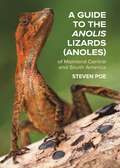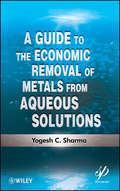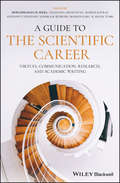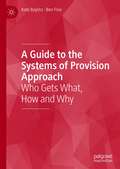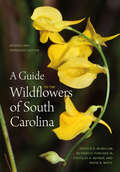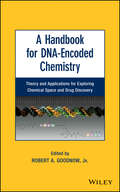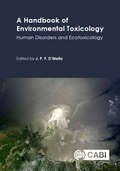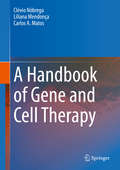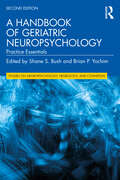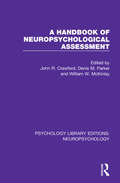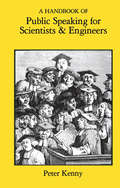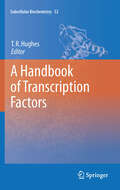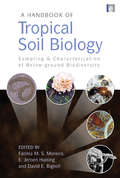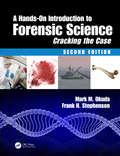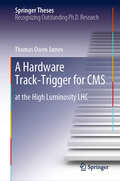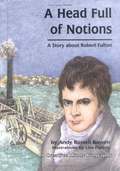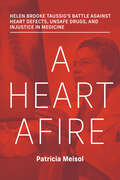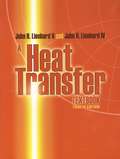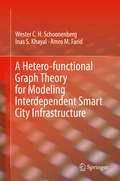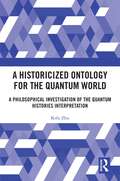- Table View
- List View
A Guide to the Anolis Lizards (Anoles) of Mainland Central and South America
by Steven PoeAn authoritative treatment of the diverse and beautiful anole lizards of mainland Central and South AmericaAnoles are highly visible and aesthetically pleasing lizards that are abundant throughout Central and South America. The subjects of countless evolutionary and ecological studies that have advanced our understanding of basic principles in biology, these colorful reptiles are notoriously difficult to identify, and species names are often confusing and inconsistent. A Guide to the Anolis Lizards (Anoles) of Mainland Central and South America is the first book to enable the identification of all known species of anole in the region while establishing baseline knowledge for further research. Drawing on the latest findings, this comprehensive field companion and taxonomic reference is the ultimate guide to these extraordinary lizards.Provides the first stable taxonomy of mainland anoles while aiding field identification of these marvelous neotropical reptilesFeatures hundreds of stunning photos depicting most species, including several species never before photographedDescribes the key identification features and natural history of over 200 species of mainland anolesFacilitates scientific research on evolution, ecology, and species discoveryAn ideal travel companion for ecotourists and other visitors to Central and South AmericaAccompanied by an online identification key
A Guide to the Economic Removal of Metals from Aqueous Solutions
by Yogesh C. SharmaWater pollution is topic of immense and common concern throughout the world. This book presents the results and data from research and adsorption experiments carried out on the removal of nickel and chromium (as well as other metals) from aqueous solutions using modified silica sand.
A Guide to the Scientific Career: Virtues, Communication, Research, and Academic Writing
by Marios Loukas R. Shane Tubbs Mohammadali M. Shoja Marion Karl Anastasia Arynchyna Anthony V. D'antoni Sandra M. BuergerA concise, easy-to-read source of essential tips and skills for writing research papers and career management In order to be truly successful in the biomedical professions, one must have excellent communication skills and networking abilities. Of equal importance is the possession of sufficient clinical knowledge, as well as a proficiency in conducting research and writing scientific papers. This unique and important book provides medical students and residents with the most commonly encountered topics in the academic and professional lifestyle, teaching them all of the practical nuances that are often only learned through experience. Written by a team of experienced professionals to help guide younger researchers, A Guide to the Scientific Career: Virtues, Communication, Research and Academic Writing features ten sections composed of seventy-four chapters that cover: qualities of research scientists; career satisfaction and its determinants; publishing in academic medicine; assessing a researcher’s scientific productivity and scholarly impact; manners in academics; communication skills; essence of collaborative research; dealing with manipulative people; writing and scientific misconduct: ethical and legal aspects; plagiarism; research regulations, proposals, grants, and practice; publication and resources; tips on writing every type of paper and report; and much more. An easy-to-read source of essential tips and skills for scientific research Emphasizes good communication skills, sound clinical judgment, knowledge of research methodology, and good writing skills Offers comprehensive guidelines that address every aspect of the medical student/resident academic and professional lifestyle Combines elements of a career-management guide and publication guide in one comprehensive reference source Includes selected personal stories by great researchers, fascinating writers, inspiring mentors, and extraordinary clinicians/scientists A Guide to the Scientific Career: Virtues, Communication, Research and Academic Writing is an excellent interdisciplinary text that will appeal to all medical students and scientists who seek to improve their writing and communication skills in order to make the most of their chosen career.
A Guide to the Systems of Provision Approach: Who Gets What, How and Why
by Ben Fine Kate BaylissUnderstanding consumption requires looking at the systems by which goods and services are provided – not just how they are produced but the historically evolved structures, power relations and cultures within which they are located. The Systems of Provision approach provides an interdisciplinary framework for unpacking these complex issues. This book provides a comprehensive account of the Systems of Provision approach, setting out core concepts and theoretical origins alongside numerous case studies. The book combines fresh understandings of everyday consumption using examples from food, housing, and water, with implications for society’s major challenges, including inequality, climate change, and prospects for capitalism. Readers do not require prior knowledge across the subject matter covered but the text remains significant for accomplished researchers and policymakers, especially those interested in the messy real world realities underpinning who gets what, how, and why across public and private provision in global, national, and historical contexts.
A Guide to the Wildflowers of South Carolina, Revised and Expanded Edition
by Patrick D. McMillan Richard D. Porcher Douglas A. Rayner and David B. WhiteA comprehensive and indispensable reference for identifying and appreciating native flora <P><P> From its summits to its shores, South Carolina brims with life and unparalleled beauty thanks to its abundant array of native and naturalized flora, all carefully documented in this revised and expanded edition of A Guide to the Wildflowers of South Carolina. Dramatic advances in plant taxonomy and ecology have occurred since the guide's publication 20 years ago; new species have been discovered while others struggle to survive in the face of vanishing habitats and climate change. <P><P> The authors, all experienced botanists, offer essays on carnivorous plants, native orchids, Carolina bays, the roles and effects of fire and agriculture on the landscape, and detailed descriptions of the plant communities throughout the state's major natural regions. This expanded edition catalogs nearly 1,000 species organized by habitat, with descriptions, color photographs, range maps, and comments on pharmacological uses, suitability for garden cultivation, origin of common and scientific names, and conservation status.
A Guided Tour of Mathematical Methods for the Physical Sciences, Third Edition
by Roel Snieder Kasper Van WijkMathematical methods are essential tools for all physical scientists. This book provides a comprehensive tour of the mathematical knowledge and techniques that are needed by students across the physical sciences. In contrast to more traditional textbooks, all the material is presented in the form of exercises. Within these exercises, basic mathematical theory and its applications in the physical sciences are well integrated. In this way, the mathematical insights that readers acquire are driven by their physical-science insight. This third edition has been completely revised: new material has been added to most chapters, and two completely new chapters on probability and statistics and on inverse problems have been added. This guided tour of mathematical techniques is instructive, applied, and fun. This book is targeted for all students of the physical sciences. It can serve as a stand-alone text, or as a source of exercises and examples to complement other textbooks.
A Handbook for DNA-Encoded Chemistry
by Robert A. Goodnow Jr.This book comprehensively describes the development and practice of DNA-encoded library synthesis technology. Together, the chapters detail an approach to drug discovery that offers an attractive addition to the portfolio of existing hit generation technologies such as high-throughput screening, structure-based drug discovery and fragment-based screening. The book:Provides a valuable guide for understanding and applying DNA-encoded combinatorial chemistry Helps chemists generate and screen novel chemical libraries of large size and quality Bridges interdisciplinary areas of DNA-encoded combinatorial chemistry - synthetic and analytical chemistry, molecular biology, informatics, and biochemistry Shows medicinal and pharmaceutical chemists how to efficiently broaden available "chemical space" for drug discovery Provides expert and up-to-date summary of reported literature for DNA-encoded and DNA-directed chemistry technology and methods
A Handbook of Bioanalysis and Drug Metabolism
by Gary EvansRecent years have seen a greater industrial emphasis in undergraduate and postgraduate courses in the pharmaceutical and chemical sciences. However, textbooks have been slow to adapt, leaving the field without a text/reference that is both instructional and practical in the industrial setting – until now. A Handbook of Bioanalysis and Drug Metabolismis a stimulating new text that examines the techniques, methodology, and theory of bioanalysis, pharmacokinetics, and metabolism from the perspective of scientists with extensive professional experience in drug discovery and development. These three areas of research help drug developers to optimize the active component within potential drugs thereby increasing their effectiveness, and to provide safety and efficacy information required by regulators when granting a drug license. Professionals with extensive experience in drug discovery and development as well as specialized knowledge of the individual topics contributed to each chapter to create a current and well-credentialed text. It covers topics such as high performance liquid chromatography, protein binding, pharmacokinetics and drug–drug interactions. The unique industrial perspective helps to reinforce theory and develop valuable analytical and interpreting skills. This text is an invaluable guide to students in courses such as pharmaceutical science, pharmacology, chemistry, physiology and toxicology, as well as professionals in the biotechnology industry.
A Handbook of Biological Investigation (Seventh Edition)
by Harrison W. Ambrose Katharine Peckham Ambrose Douglas J. Emlen Kerry L. BrightThis book is written as a reference aid to be used by biology students at any time they are first exposed to the scientific method and to original research. It guides the beginner through elementary experimental design, data collection and analysis, and the subsequent writing of a scientific report. In addition, it provides an introduction to the literature of biology and a basic search strategy for finding relevant, published information in a library.
A Handbook of Environmental Toxicology: Human Disorders and Ecotoxicology
by Nikki Jones Aftab Ahmad Marina Santana Alberto Gomez Arturo Aburto-Medina L. Agullo-Chazarra Shama Ahmad A. Ahmad Agneta Akesson Sandra Arismendez Andy S. Ball E. Barrajon-Catalan William M. Caudle L. M. Crosby P. D. Darbre R Del Kollerud Miguel Dopico C. J. Everett N. Fuentes N. Hachiya N. Haleyur V. Harrison S. Haycox G. Z. He M. Herranz-Lopez Y.C.T. Huang H. Jiang A. L. Katner Maria Kippler N. Kovats P. J. Lein Chan Juan Liang Johan Lundqvist S. J. Ross A. A. Mansur Boris Melloni James S. Metcalf V. Micol H. W. Mielke Paul A. Montagna C. Noubactep W. H. Orem J. M. Otaki Daniela M. Pampanin Almudena Perez-Sanchez David A. Purser L. Rivera D. Schlenk S. Seneff S. Sethi Esmaeil Shahsavari P. Silveyra X. F. Sima Nara R. Souza Jan A. Staessen Horst Thiermann K. C. Thompson Jesse L. Tucker Jouko Tuomisto A. Turra Matti Viluksela Timo Wille M. J. Wilson Franz Worek Wenyi YangA Handbook of Environmental Toxicology focuses on two key aspects: human disorders and ecotoxicology as affected by major toxins originating from biological sources and pollutants, as well as radiation generated spontaneously or as a result of anthropogenic activity. A diverse array of these potentially harmful agents regularly appear in the atmosphere, soil, water and food, compromising both human health and biodiversity in natural and managed ecosystems. This book: - provides authoritative reviews together with specialist short communications to complement the main chapters and address contemporary issues with important case studies; - explores the cutting edge of research and also indicates the likely direction of future developments; - contains extensive coverage of toxicants that are of significant current interest and will be of increasing concern for many years to come; and - encourages international cooperation in future research on pollution and other environmental agents causing harm to human health and degradation of natural habitats in the ecosystem. Written by an international team of authors from a range of educational, medical and research establishments, this book is an essential reference for advanced students and researchers in the areas of environmental sciences, ecology, agriculture, environmental health and medicine, in addition to industry and government personnel responsible for environmental regulations and directives.
A Handbook of Gene and Cell Therapy
by Clévio Nóbrega Liliana Mendonça Carlos A. MatosThis is a reference handbook for young researchers exploring gene and cell therapy. Gene therapy could be defined as a set of strategies modifying gene expression or correcting mutant/defective genes through the administration of DNA (or RNA) to cells, in order to treat disease. Important advances like the discovery of RNA interference, the completion of the Human Genome project or the development of induced pluripotent stem cells (iPSc) and the basics of gene therapy are covered. This is a great book for students, teachers, biomedical researchers delving into gene/cell therapy or researchers borrowing skills from this scientific field.
A Handbook of Geriatric Neuropsychology: Practice Essentials (Studies on Neuropsychology, Neurology and Cognition)
by Shane S. Bush Brian P. YochimA Handbook of Geriatric Neuropsychology: Practice Essentials (Second Edition) brings together experts in the field to integrate the knowledge and skills needed to understand and treat older adults who are experiencing problems with memory and other thinking skills. With three new sections, including coverage of other conditions beyond neuropsychological disorders, special assessment contexts, and more on interventions and ethics, as well as multiple new chapters, and significant updates from the first edition, this book provides a strong foundation for clinicians, educators, and researchers invested in the wellbeing of older adults. The impact and experience of aging, like the practice of neuropsychology, evolves over time. Similarly, through advances in science and professional techniques, neuropsychological practice has continued to evolve. Neuropsychological evaluation remains the most effective method of diagnosing age-related cognitive decline, cognitive difficulties that result from psychological factors, and other related disorders, as well as determining how the various disorders impact functioning and quality of life. This book explores these areas and offers state-of-the-art assessment techniques to assess changes in cognition and behavior and to distinguish normal changes from neuropathology. This book is a go-to resource and key reference for psychologists who serve older adults with known or suspected cognitive problems, as well as those who are invested in promoting brain wellness. It provides much of the information needed to establish and improve foundational and functional competencies in geriatric neuropsychology and establish practices that are personally and professionally rewarding, all aimed at promoting the understanding and wellbeing of older adults.
A Handbook of Global Freshwater Invasive Species
by Robert A. FrancisInvasive non-native species are a major threat to global biodiversity. Often introduced accidentally through international travel or trade, they invade and colonize new habitats, often with devastating consequences for the local flora and fauna. Their environmental impacts can range from damage to resource production (e.g. agriculture and forestry) and infrastructure (e.g. buildings, road and water supply), to human health. They consequently can have major economic impacts. It is a priority to prevent their introduction and spread, as well as to control them. Freshwater ecosystems are particularly at risk from invasions and are landscape corridors that facilitate the spread of invasives. This book reviews the current state of knowledge of the most notable global invasive freshwater species or groups, based on their severity of economic impact, geographic distribution outside of their native range, extent of research, and recognition of the ecological severity of the impact of the species by the IUCN. As well as some of the very well-known species, the book also covers some invasives that are emerging as serious threats. Examples covered include a range of aquatic and riparian plants, insects, molluscs, crustacea, fish, amphibians, reptiles and mammals, as well as some major pathogens of aquatic organisms. The book also includes overview chapters synthesizing the ecological impact of invasive species in fresh water and summarizing practical implications for the management of rivers and other freshwater habitats.
A Handbook of Neuropsychological Assessment (Psychology Library Editions: Neuropsychology #3)
by John R. Crawford Denis M. Parker William W. MckinlayOriginally published in 1992, this is a wide-ranging text concerned with the principles and practice of neuropsychological assessment in adults. It combines a flexible hypothesis testing approach to assessment with information on specialised test batteries. The book covers the major areas of memory, language, perception, attention, and executive dysfunctions, and includes chapters on dementia, alcohol, drug and toxic conditions, stroke and closed head injury. Assessment of dysfunction in cases involving claims for compensation and chapters on specialised assessment techniques, including automated test procedures, are provided. The book presents a sound introduction to this complex area and gives guidelines for the clinician who may need concise information on a specialised topic.
A Handbook of Public Speaking for Scientists and Engineers
by Peter KennyA Handbook of Public Speaking for Scientists and Engineers helps scientists and engineers improve their skills at speaking in public in the course of their professional activities. The book shows how best to prepare papers for presentation at a technical conference and how to put cases to committee meetings. Not only does the book deal with specific events, but it also provides the techniques of more effective speaking, whether presenting papers, answering questions, or speaking "off-the-cuff." The book is written in a highly entertaining manner and should put all complacent lecturers on their guard.
A Handbook of Transcription Factors: Handbook Of Transcription Factors (Subcellular Biochemistry #52)
by Timothy R. HughesTranscription factors are the molecules that the cell uses to interpret the genome: they possess sequence-specific DNA-binding activity, and either directly or indirectly influence the transcription of genes. In aggregate, transcription factors control gene expression and genome organization, and play a pivotal role in many aspects of physiology and evolution. This book provides a reference for major aspects of transcription factor function, encompassing a general catalogue of known transcription factor classes, origins and evolution of specific transcription factor types, methods for studying transcription factor binding sites in vitro, in vivo, and in silico, and mechanisms of interaction with chromatin and RNA polymerase.
A Handbook of Tropical Soil Biology: Sampling and Characterization of Below-ground Biodiversity
by Fatima M. Moreira E. Jeroen Huising David E. BignellThis practical handbook describes sampling and laboratory assessment methods for the biodiversity of a number of key functional groups of soil organisms, including insects, earthworms, nematodes, fungi and bacteria. The methods have been assembled and the protocols drafted by a number of scientists associated with the UNEP-GEF funded Conservation and Sustainable Management of Below-Ground Biodiversity Project, executed by the Tropical Soil Biology and Fertility (TSBF) Institute of the International Center for Tropical Agriculture (CIAT). The methods provide a standardized basis for characterizing soil biodiversity and current land uses in terrestrial natural, semi-natural and agroecosystems in tropical forests and at forest margins. The aim is to assess soil biodiversity against current and historic land use practices both at plot and landscape scales and, further, to identify opportunities for improved sustainable land management through the introduction, management or remediation of soil biota, thus reducing the need for external inputs such as fertilizers and pesticides. The book also contains extensive advice on the handling of specimens and the allocation of organisms to strain or functional group type. Published with TSBF-CIAT, CTA, UNEP and GEF
A Hands-On Course in Sensors Using the Arduino and Raspberry Pi (Series in Sensors)
by Volker ZiemannA Hands-On Course in Sensors using the Arduino and Raspberry Pi is the first book to give a practical and wide-ranging account of how to interface sensors and actuators with micro-controllers, Raspberry Pi and other control systems. The author describes the progression of raw signals through conditioning stages, digitization, data storage and presentation. <P><P>The collection, processing, and understanding of sensor data plays a central role in industrial and scientific activities. This book builds simplified models of large industrial or scientific installations that contain hardware and other building blocks, including services for databases, web servers, control systems, and messaging brokers. A range of case studies are included within the book, including a weather station, geophones, a water-colour monitor, capacitance measurement, the profile of laser beam, and a remote-controlled and fire-seeking robot <P><P>This book is suitable for advanced undergraduate and graduate students taking hands-on laboratory courses in physics and engineering. Hobbyists in robotics clubs and other enthusiasts will also find this book of interest. <P><P>Features: <li>Includes practical, hands-on exercises that can be conducted in student labs, or even at home <li>Covers the latest software and hardware, and all code featured in examples is discussed in detail <li>All steps are illustrated with practical examples and case studies to enhance learning
A Hands-On Introduction to Forensic Science: Cracking the Case, Second Edition
by Mark M. Okuda Frank H. Stephenson, PhD.A Hands-On Introduction to Forensic Science, Second Edition continues in the tradition of the first edition taking a wholly unique approach to teaching forensic science. Each chapter begins with a brief, fictional narrative that runs through the entire book; it is a crime fiction narrative that describes the interaction of a veteran homicide detective teamed with a criminalist and the journey they take together to solve a missing persons case. Step-by-step the book progressive reveals pieces of information about the crime, followed by the more traditional presentation of scientific principles and concepts on a given forensic topics. Each chapter concludes with a series of user friendly, cost effective, hands-on lab activities that provide the students the skills necessary to analyze the evidence presented in each chapters. The new edition is completely updated with special focus on new DNA techniques in DNA sequencing, DNA phenotyping, and bioinformatics. Students will engage in solving a missing persons case by documenting the crime scene, analyzing physical evidence in the lab, and presenting findings in a mock trial setting. Within the chapters themselves, students learn about the technical, forensic concepts presented within each of the opening stories segments. The book culminates with having the students playing to role of the main characters in a trial—attorneys, scientific experts, suspect, judge, bailiff, and jury—to present and judge the evidence in a mock trial setting. The mock trial will mimic what takes place in a real courtroom, and the jury of swill be asked to deliberate on the evidence presented to determine the guilt or innocence of the suspect.
A Hardware Track-Trigger for CMS: at the High Luminosity LHC (Springer Theses)
by Thomas Owen JamesThe work described in this PhD thesis is a study of a real implementation of a track-finder system which could provide reconstructed high transverse momentum tracks to the first-level trigger of the High Luminosity LHC upgrade of the CMS experiment. This is vital for the future success of CMS, since otherwise it will be impossible to achieve the trigger selectivity needed to contain the very high event rates. The unique and extremely challenging requirement of the system is to utilise the enormous volume of tracker data within a few microseconds to arrive at a trigger decision.The track-finder demonstrator described proved unequivocally, using existing hardware, that a real-time track-finder could be built using present-generation FPGA-based technology which would meet the latency and performance requirements of the future tracker. This means that more advanced hardware customised for the new CMS tracker should be even more capable, and will deliver very significant gains for the future physics returns from the LHC.
A Head Full of Notions: A Story about Robert Fulton
by Andy Russell BowenDescribes the life and work of the talented inventor and resourceful businessman, with special emphasis on his development of the steamboat.
A Heart Afire: Helen Brooke Taussig's Battle Against Heart Defects, Unsafe Drugs, and Injustice in Medicine
by Patricia MeisolA deeply compelling biography of the pioneering children�s heart doctor Helen Taussig, who helped start heart surgery and became a global force against preventable suffering.
A Heat Transfer Textbook: Fourth Edition
by John H Lienhard VThis introduction to heat transfer offers advanced undergraduate and graduate engineering students a solid foundation in the subjects of conduction, convection, radiation, and phase-change, in addition to the related topic of mass transfer. A staple of engineering courses around the world for more than three decades, it has been revised and updated regularly by the authors, a pair of recognized experts in the field. The text addresses the implications, limitations, and meanings of many aspects of heat transfer, connecting the subject to its real-world applications and developing students' insight into related phenomena. Three introductory chapters form a minicourse in heat transfer, covering all of the subjects discussed in detail in subsequent chapters. This unique and effective feature introduces heat exchangers early in the development, rather than at the end. The authors also present a novel and simplified method for dimensional analysis, and they capitalize on the similarity of natural convection and film condensation to develop these two topics in a parallel manner. Worked examples and end-of-chapter exercises appear throughout the book, along with well-drawn, illuminating figures.
A Hetero-functional Graph Theory for Modeling Interdependent Smart City Infrastructure
by Amro M. Farid Inas S. Khayal Wester C. SchoonenbergCities have always played a prominent role in the prosperity of civilization. Indeed, every great civilization we can think of is associated with the prominence of one or more thriving cities. And so understanding cities -- their inhabitants, their institutions, their infrastructure -- what they are and how they work independently and together -- is of fundamental importance to our collective growth as a human civilization. Furthermore, the 21st century “smart” city, as a result global climate change and large-scale urbanization, will emerge as a societal grand challenge. This book focuses on the role of interdependent infrastructure systems in such smart cities especially as it relates to timely and poignant questions about resilience and sustainability. In particular, the goal of this book is to present, in one volume, a consistent Hetero-Functional Graph Theoretic (HFGT) treatment of interdependent smart city infrastructures as an overarching application domain of engineering systems. This work may be contrasted to the growing literature on multi-layer networks, which despite significant theoretical advances in recent years, has modeling limitations that prevent their real-world application to interdependent smart city infrastructures of arbitrary topology. In contrast, this book demonstrates that HFGT can be applied extensibly to an arbitrary number of arbitrarily connected topologies of interdependent smart city infrastructures. It also integrates, for the first time, all six matrices of HFGT in a single system adjacency matrix. The book makes every effort to be accessible to a broad audience of infrastructure system practitioners and researchers (e.g. electric power system planners, transportation engineers, and hydrologists, etc.). Consequently, the book has extensively visualized the graph theoretic concepts for greater intuition and clarity. Nevertheless, the book does require a common methodological base of its readers and directs itself to the Model-Based Systems Engineering (MBSE) community and the Network Science Community (NSC). To the MBSE community, we hope that HFGT will be accepted as a quantification of many of the structural concepts found in model-based systems engineering languages like SysML. To the NSC, we hope to present a new view as how to construct graphs with fundamentally different meaning and insight. Finally, it is our hope that HFGT serves to overcome many of the theoretical and modeling limitations that have hindered our ability to systematically understand the structure and function of smart cities.
A Historicized Ontology for the Quantum World: A Philosophical Investigation of the Quantum Histories Interpretation
by Kefu ZhuThis book discusses the ontology in the quantum world and argues that it should be interpreted as a historicized ontology. This perspective is advocated by the quantum histories interpretation.Inspired by the nomological interpretation from Bohmian mechanics and the corresponding understanding of the law of nature and logic, the ontology will be useful to solve the difficulties of confusing ontology and perplexing logical inference. Furthermore, this book proposes that the historicized ontology can be generalized to more complicated structures and fit naturally into temporal correlation. Core philosophical issues such as the law of nature, the ontology of events, history, and processes, and the metaphysics of history are coherently discussed, revealing the profound meaning behind the formalism of quantum histories. By providing a new framework for a historicized picture of ontology, it will effectively promote the debates in the philosophy of physics and the fundamental research in quantum mechanics.This book will appeal to scholars and students of the philosophy of science, metaphysics, and quantum theory.
